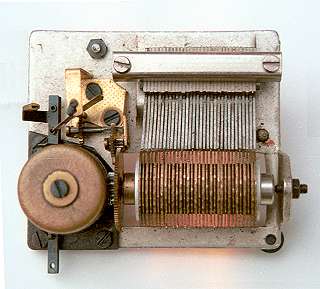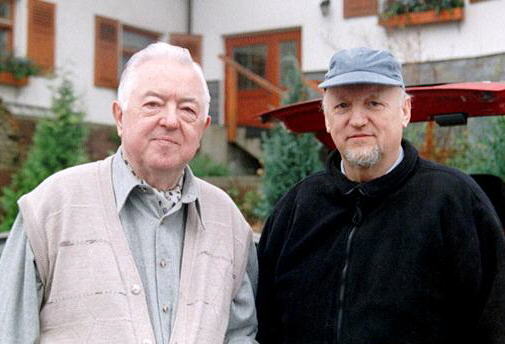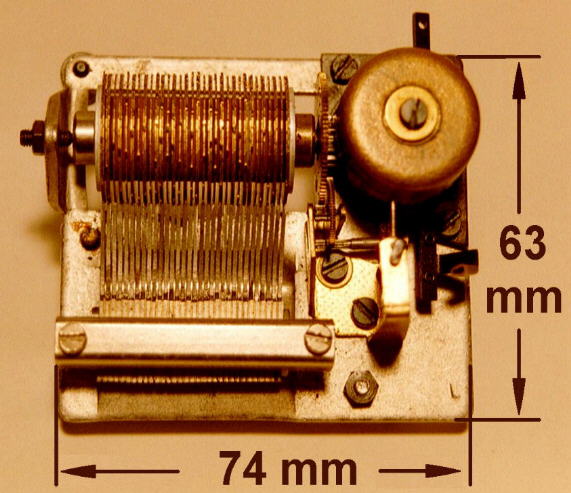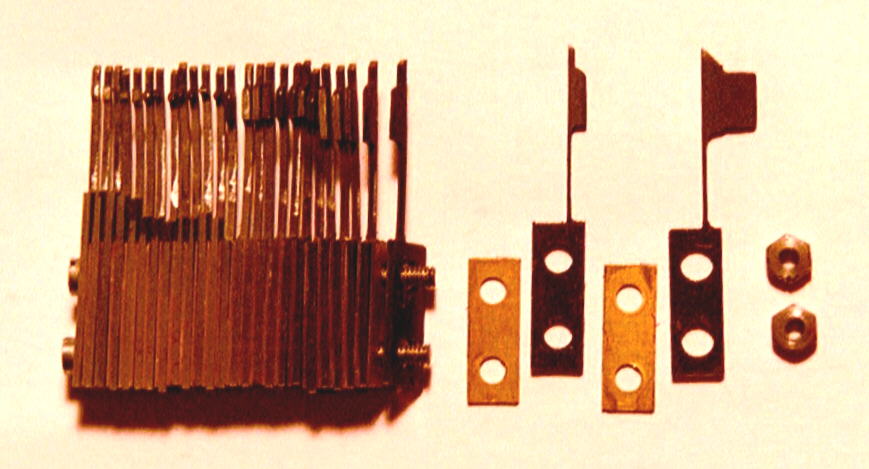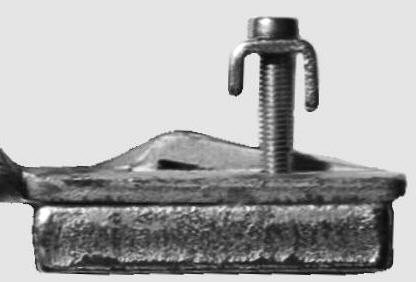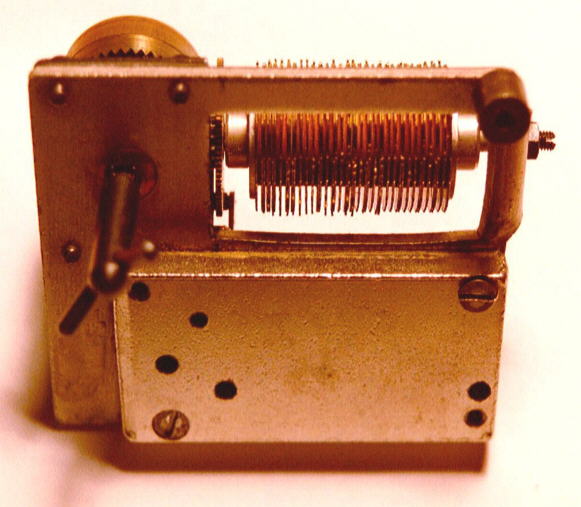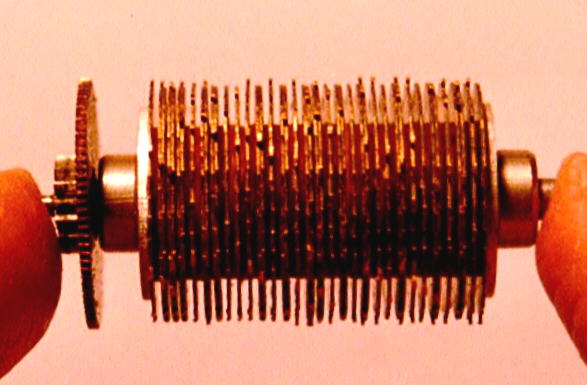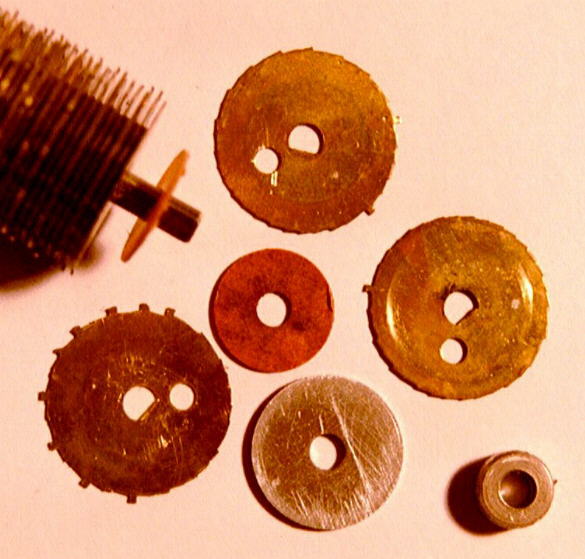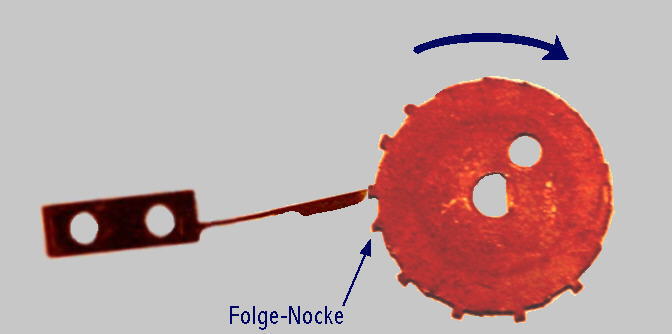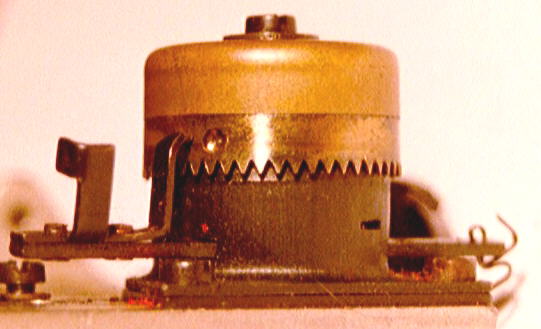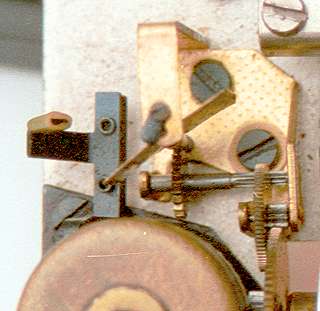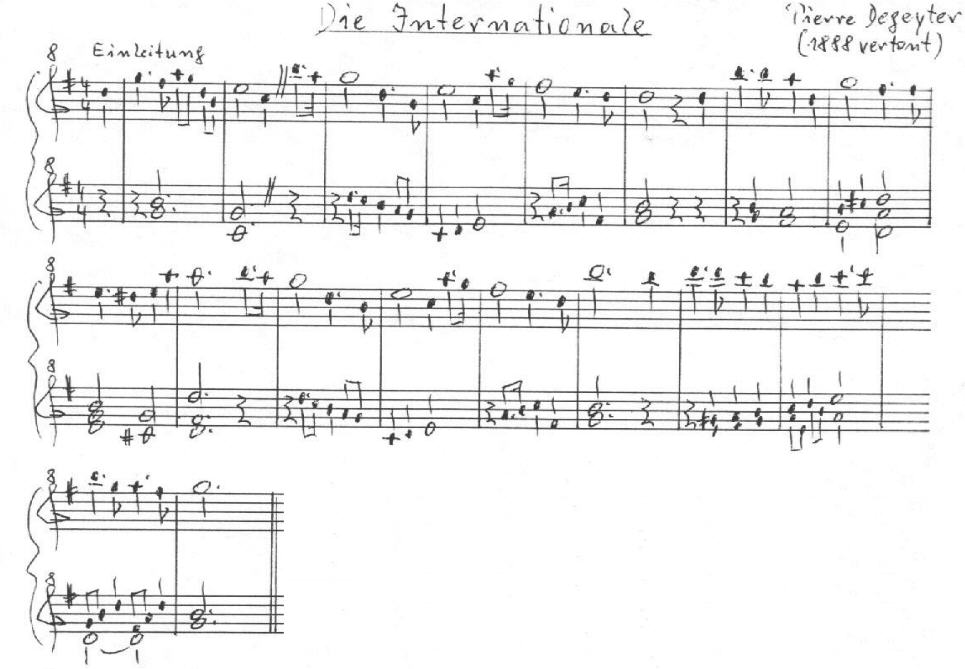| You Are Not Logged In | Login/Get New Account |
|
Please Log In. Accounts are free!
Logged In users are granted additional features including a more current version of the Archives and a simplified process for submitting articles. |
|
MMD
 Tech
Tech
 DDRL
DDRL
 DDRL_en
DDRL_en
|
|
by Hauke Marxsen
First published in the journal, „Das Mechanische
Musikinstrument” (Journal der „Gesellschaft
Contents: Preface
In issues 64 (Dec. 1995) and 65 (April 1996) of this journal I stumbled upon the so-called "DDR movement". [DDR, the Deutsche Demokratische Republik , better known as East Germany, existed from 1949 until 1990.] The first article was written by Mr. Herbert Gerbeth and the second by Mr. Johannes Hennig. My interest areas are the small cylinder movements for musical boxes, and an example from the DDR was missing in my collection. The articles had made me curious and so I searched for such a device. Only in spring 2000 could I acquire the first example, on the occasion of the "Musica Mechanica" mart in Rüdesheim. It's now in my collection, along with a second, defective movement which I dismantled completely (sacrificed) and photographed for the descriptions of this article. I visited Mister Helmut Herold (see illustration 1a) at the end of November 2000 in Klingenthal. From the beginning of production until the end he was the technical and commercial head of the state-owned project "Spieluhren-Laufwerke" ["Music Box Movements"] in the ex-DDR. Mr. Herold took the time to explain several technical details to me, and to tell me some interesting stories. His father, an accordion maker, saw to it that as a child the boy received musical instruction early on. He learned the occupation of an industry merchandiser and later, after earning a degree in business administration, he advanced to business manager. Technology was not foreign to him, either.
The former president of the GDR (president from 1949 to 1960), Wilhelm Pieck (the name surely sounds familiar to many), arranged in 1956 to produce music box movements in Klingenthal, Saxony [east of Hof, by the Czech border]. He wanted the DDR economy to become independent of the imports from Switzerland. From 1961 up to the end of the DDR, these unique movements were produced in Klingenthal; over many years the product was affiliated with "VEB Harmony", and throughout the last 10 years with "VEB Music Electronics". 20 persons in a work building were employed with planning and prefabrication of music box movements, 25 in final assembly, and 5 persons were employed as cottage industry. Final assembly took place in an annex to the residence of Mister Herold and was directed by his wife. Approximately 30,000 units of these remarkable devices were produced each year, therefore altogether almost one million. Except for the gears and the governers (speed regulators), which were provided by a firm in Glashütte, everything was made in Klingenthal. An important co-worker was Mister Herbert Gerbeth, who arranged the music for all the different melodies (designing the cam disks and the companion comb). Approximately 40 different tune cylinders and combs were realized, some with one melody, some with two melodies per cylinder. In addition, a variation has become known to the author which has two melodies on it and the first few bars of a third. Mainly, the products were installed in music boxes with a built-in turntable.
The turned or carved figures usually found on the turntable are typical
of the Erzgebirge region (see illustration 1b).
Almost everything about the DDR movement (see Illustration 2) is a bit different than with devices which I have usually seen. The DDR product is distinguishable in that * the cylinder consists not of a brass tube with inserted pins, but was assembled out of punched cam-disks; * the comb wasn't sawn from a steel-plate, but for each tone a single tine was punched from steel sheet metal and all the tines were bolted together into one block; * the tongues amazingly display no dampers, but nevertheless one hears a moderately undisturbed play; * The key is turned to the left (counter-clockwise) to wind the spring, and the sping housing turns while playing until a special mechanism (controlled via the spring casing) again halts the mechanism after three revolutions of the cylinder.
The tongues were punched out of soft steel sheet, 0.7 mm thickness,
in only a few basic forms. After hardening the steel the bridge between
the rectangular part and the weight at the tip of the tongue was ground
(in accordance with the pitch desired). Two screws hold the block
of tongues together (see illustration 3), therefore the two holes are in
the rectangular area of a tongue. Between the tongues, in the area
of the rectangular part, spacers of brass approximately 0.4 mm thick were
inserted.
The comb is fastened on a beveled plane upon the steel baseplate with the help of a U-shaped holding clip and two screws on both sides (see illustration 4). Until about 1968 a steel plate was screwed on below the baseplate in the area of the comb (62 x 32 x 6 mm / see illustration 5), in order to suppress interfering vibrations. For sound improvement purposes the baseplate was altered in 1968 and
so the steel plate could be omitted. Combs with 22 to 32 tongues
were produced; the bulk of the versions have 27 to 30 tongues, depending
on melody variations.
The cylinder (see illustration 6a & 6b) consists of approximately 0.4 mm thick cam disks punched from hard brass; the diameters are approximately 23 mm including cams. Between the cam disks lie spacing disks of a plastic-like cardboard. The shaft on which the disks are lined up has an eccentric D-shape cross-section. Also the hole in the middle of a disk has the form of the cross-section of the shaft; so it is consequently guaranteed that the disks are always solidly positioned. A pressed ring, holding the disk bundle together, sits at the end the shaft. The eccentric second hole in the disk served as an assembly aid. At some tongues there are double cam disks without spacer disks between;
i.e., one tongue serves a pair of disks. This was actually a stopgap,
to alter the music timing. The machine which punched the cam disks could
make the cam teeth only in solid, relatively big steps on the disk edge.
If a quickly repeating note was required, then a second cam disk was installed,
but with the cams offset a few degrees.
Missing dampers under the tongues A problem with musical box movements is the so-called damping of the tongues. In the the customary drive with a pinned cylinder, the tongue vibrates for a while after it is plucked; with deeper tones it vibrates longer. If another pin approaches while the tongue still swings, then one will hear a rattle and clank because the vibrating tongue beats against the approaching pin. Therefore the expensive high-quality drives from Switzerland, and also the cheap drives from the Far east, have damper pennants (tiny strips of plastic) installed under the ends of the tongues, especially for the deep tones (sees illustration 8). This method halts the swinging tongue gently -- if another pin approaches, the pin first makes contact with the damper, which stops the vibration of the tongue. The problem of the conventional system is that the plastic dampers are
glued under the tongue, and they may wear or fall off or break after some
years or decades.
Such dampers are missing in the DDR movement. Should a tone sound consecutively several times within a short period, one can assume that the tongue still vibrates when the next cam tooth approaches. Upon more critical examination, one sees that the front edge of the approaching cam tooth has a diagonal slope (see illustration 9), so that a bit more time is available (a few tenths of seconds) for the tongue to stop swinging. If this correction was not enough, then the notes were distibuted over two or even three tongues and cams, and were plucked alternately.
Drive module and stop control mechanism The drum, inside which is located the main-spring (see illustration 10), rotates during playing and drives the cylinder via teeth on the end of the drum. A tiny finger presses upon the outside of the spring drum and, after one revolution of the drum, the sensing finger falls into a small hole to stop the turning (see illustration 11). One revolution of the spring drum causes 3 revolutions of the 30-second cylinder, thus the music plays for about 90 seconds before stopping. In other words, after the start lever is pressed, the spring casing makes one revolution before it stops; because of the 3-to-1 gear relationship the cylinder meanwhile rotates 3 times. Consequently, one hears the music program three times consecutively (very pleasantly). Normally it is customary that a drive is stopped after one cylinder revolution (my feeling is too soon), or else it runs for a very long time, until the strength of the main-spring is spent (my feeling is too long).
The Inhibitor (speed-regulator) The inhibitor (speed-regulator) hardly differs from speed-regulators of other manufacturers. As already mentioned, this component and the gears which were installed came from a supplier in Glashütte, a town famous for clockmakers. This supplier primarily produced accessories for model railroads.
The first musical boxes furnished with the DDR movement played the song
„Sandmann,
lieber Sandmann", the theme melody of a TV series, "The Sandman", which
was popular at the time. The box sold for 56 East German marks.
The hourly wage of a skilled worker at that time was around 1.50 to 2.00
DDR marks per hour.
For Lenin's 100th birthday celebration 500 boxes were prepared for the ZK with the melody „The International". [The Communist Zentralkommittee (ZK) was the highest government body of the state.] Since the original melody was much too long for the single-revolution cylinder, it had to be shortened so much that it was hardly conspicuous. (See illustration 11.) Four months after the birthday jubilee a Stasi (state security service) agent came from Berlin and interrogated Messrs Herold and Gerbeth for several hours (Was it sabotaged? Was somebody trying to communicate something? Was „The International" intentionally slandered?). In the end the Stasi agent accepted the purely technical reason for
the shortened tune, and he issued only an admonition. Mister Gerbeth
was very kind and gave me the manuscript, just as it was arranged for the
movement (see Illustration 11).
Another incident occurred in 1972, when two Stasi agents interrogated Messrs Herold and Gerbeth again, but this time for a whole day long. A music box had been produced with the folk song „Bald gras ich am Neckar, bald gras ich am Rhein" ["Soon I'll graze (grow grain) at the Neckar, soon I'll graze at the Rhine..."]. A scandal, indeed, to glorify scenes of the West (was an appeal to flee the country behind it?). [It was not possible for a normal person to travel to the West. Many dreamed to be as soon as possible somewhere in West Germany; many made it.] Since Mister Gerbeth was able to prove that the traditional folk song was also printed in the DDR, Messrs Herold and Gerbeth were spared a "Sojurn in Bautzen" [a place for political prisoners]. Some months later the identity of the person who triggered the action seeped through to Klingenthal. A music box had been given to a functionary high up in Honecker's orbit. She was displeased with the lyrics of the song, and she probably was going to polish her image with this action against the two music box makers. Production had to stop and all boxes which had been delivered to stores for sale had to be returned to Klingenthal. All movements were ordered to be scrapped, but the destruction wasn't carried out. A short time later all the music boxes were sold in special "International
Shops" where only selected people could buy things with West German Marks.
There they could cause no more ideological damage and yet bring the sought-after
Deutsche Mark into the country.
Both men were very open and approachable, and I left with them some Thorens music box movements (28 teeth, sliding cylinder, 2 music titles). They came from Switzerland and may have been produced in the 1970s. A postcard from Mr. Gerbeth reached me for Christmas 2000, from which one can infer something about the sound quality of the GDR movement:: " [...] Heartfelt thanks for the movement. It sounds very beautiful and clean. The tone is quite fine in contrast to the Klingenthaler movement [the DDR movement]. There the overtones sound powerful and rich [...]."
The costly technology and the presumably very high labor costs (the result of Germany's reunification in 1990) lead to the turning point and thus the "end" of the production. The plastic components are the deficiency in the drives of the other manufacturers (the Far East and also Switzerland) that were produced after World War 2. The plastic becomes brittle after a few decades and breaks off (dampers, gears, speed regulator, etc.). Apart from the uncritical spacing disks inserted between the cam disks, no plastic or similar material has been put into the DDR movements. It is to be assumed that such a drive will work in one hundred years as well. A few years before the political change of 1990 another company in East Germany tried to build movements that resembled the technology of the Swiss drives (a brass-tube cylinder with inserted pins, a comb sawed from steel plate) but with no satisfying result. Messrs Herold and Gerbeth are at this point again heartiliy thanked for their share in the realization of this article. In their possession are only a few DDR movements and those are understandably keepsakes and are not for sale. A special thanks to Robbie Rhodes who has patiently translated this article into English, and to Frank Metzger for his critical review and suggestions. Illustrations not otherwise credited:
13 February 2001, 26 December 2001 |
|
|
|
|
|
|
|
|
|
CONTACT FORM: Click HERE to write to the editor, or to post a message about Mechanical Musical Instruments to the MMD Unless otherwise noted, all opinions are those of the individual authors and may not represent those of the editors. Compilation copyright 1995-2026 by Jody Kravitz. Please read our Republication Policy before copying information from or creating links to this web site. Click HERE to contact the webmaster regarding problems with the website. |
|
|
||||||
|
